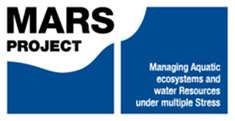Biological stressors
Biological stressors are caused by alterations to water body or catchment biology, often as a result of human activity. Examples of pressures causing biological stressors include:
- The introduction of invasive non-native species, often through ballast water, canals connected to river basins, deliberate introductions, and releases from aquaria, gardens and bait buckets (Strayer 2010).
- Overfishing and fish stocking - both commercial and recreational angling activities can significantly alter freshwater ecosystems through their (sometimes over-)harvesting of targeted fish stocks
Effects on ecological status of aquatic ecosystems
Biological stressors can cause a number of impacts on the ecological status of aquatic ecosystems and the ecosystem services they provide.
Invasive species – non-native species introduced – intentionally or unintentionally – into an ecosystem may predate native species, lack predators, out-compete for food and habitat, or otherwise alter the functioning and food webs of the invaded ecosystem. Invasive species thus often negatively impact the conservation of imperiled native species and their establishment can make ecosystem restoration significantly more challenging (Strayer 2010).
Overfishing and fish stocking – Over-harvesting in commercial inland fisheries can cause target species to become endangered or even extinct, for example sturgeon populations in the Lower Danube (Allan et al. 2005, WWF 2015). By-catch of non-target species can also affect ecosystem structure and status. Recreational fishery management and use (e.g. fish stocking, habitat alteration, predator removal, catch and release) can significantly alter fish communities, ecosystem structure and functioning, and food webs in aquatic ecosystems, but remains poorly monitored (Cooke & Cowx 2004)
Common combinations as multiple stressors
Invasive species interact with chemical stressors, hydrological stressors and morphological stressors, and have the potential to significantly influence water management. As disturbance is thought to favour invasions, highly stressed and altered ecosystems may be especially susceptible to invasions, which then may in turn alter the hydrology, biogeochemical cycling, and biotic composition of the invaded ecosystem. These interactions are common, strong and bi-directional, so that management of alien species is inextricably linked to management of other freshwater stressors (Strayer 2010). However, thus far, interactions between invasive species and other stressors are poorly studied.
Examples
The so-called 'killer shrimp’, Dikerogammarus villosus, is native to the Ponto-Caspian region of eastern Europe and has invaded western Europe. It belongs to Europe's 100 'worst' invasive species (DAISIE website). The ‘killer shrimp’ is a comparatively large species which can process leaf litter at a faster rate than smaller shrimps.
In addition, ‘killer shrimp’ leaf litter processing rates increase at a faster rate in response to increasing water temperatures than the similar-sized Gammarus. This means that any decreases in ecosystem functioning caused by the displacement of Gammarus populations by ‘killer shrimp’ invasions may be offset by increases in leaf-litter processing in the invasive species where water temperatures are increased (Kenna et al, 2017, Freshwater Blog 2017).
The red-eared slider turtle or common slider (Trachemys scripta elegans) – also listed on Europe 100 'worst' invasive species (DAISIE website) – outcompetes native biodiversity, particularly the endangered European pond turtle Emys orbicularis for habitat and food. ‘Sliders’ may also contribute to the spread of diseases harmful to humans and other species (DAISIE 2006).
Further reading
MARS publications:
Borza P., Huber T., Leitner P., Remund N. & W. Graf (2016). Current velocity shapes co-existence patterns among invasive Dikerogammarus species. Freshwater Biology, online, http://dx.doi.org/10.1111/fwb.12869 (Read abstract)
Logez M., Agaciak B., Argillier C., Lepage M., Teichert N., Schinegger R., Schmutz S., Segurado P. , Ferreira M.T., Chust G., Uriarte A. & A. Borja (2017). Deliverable D5.D: Report on the position of exotic species in the context of estuaries, rivers and lakes multi-stressors and regarding ecosystem services (Download report, 3.2mb)
Reports and publications:
Allan J.D., Abell R., Hogan Z., Revenga C., Taylor B.W., Welcomme R.L. & K. Winemiller (2005). Overfishing of Inland Waters. BioScience, 55 (12): 1041-1051. DOI: 10.1641/0006-3568(2005)055[1041:OOIW]2.0.CO;2 (Download report, 4mb)
Cooke S.J. & I.G. Cowx (2004). The Role of Recreational Fishing in Global Fish Crises. BioScience, 54 (9): 857-859. doi: 10.1641/0006-3568(2004)054[0857:TRORFI]2.0.CO;2 (Download report, 182kb)
EEA (2010). Towards an early warning and information system for invasive alien species (IAS) threatening biodiversity in Europe - (Download report, 2mb)
Strayer, D.L. (2010). Alien species in fresh waters: ecological effects, interactions with other stressors, and prospects for the future. Freshwater Biology, 55: 152–174. http://doi.org/10.1111/j.1365-2427.2009.02380.x (Download report, 427kb)
Selected Freshwater Blogs:
Freshwater Blog (2017). Antagonistic interactions between biological invasion and climate warming stressors in freshwaters (External website)
Freshwater Blog (2016). Christian Feld on 'What Can I Do to Help Freshwater Ecosystems?' (External website)
Freshwater Blog (2016). Taking stock and looking forward in aquatic conservation (External website)
Freshwater Blog (2016). Invasion of the Swamp Monster (External website)
Freshwater Blog (2012). Regulating trade may hold key to stopping spread of deadly amphibian disease (External website)
Freshwater Blog (2010). Polar explorers: natives and invasives in Antarctica (External website)
Freshwater Blog (2010). What is a natural freshwater ecosystem: invasions, aliens and novel ecosystems (External website)
Other websites:
DAISIE - Delivering Alien Invasive Species Inventories for Europe (External website)
European Alien Species Information Network (External website)
WWF (2015). Danube Sturgeons (External Website)



